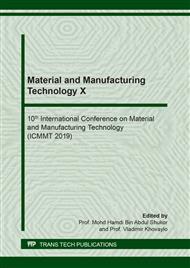p.3
p.8
p.13
p.18
p.23
p.29
p.35
p.40
Effect of Cold Rolling and Annealing Temperature on the Characteristics of Cu-28Zn-5.5Al Alloy Produced by Gravity Casting for Bullet Case Application
Abstract:
Bullet cases are usually made of Cu-28Zn alloy through various kinds of process such as cold rolling, deep drawing, and annealing. Alloying is needed to improve properties that increase forming capabilities of cartridge brass, one option is by addition of Al. Samples used in this research were prepared by melting Cu, Zn, and Al ingots in an induction furnace, followed by gravity casting. As cast samples were homogenized at 800 °C for 2 h followed by cold rolling for 5, 10 and 20 %. Annealing was conducted on the 20 % deformed samples at 300, 400, and 600 °C for 30 min. Hardness and microstructures formed by each treatment were then evaluated using Vickers microhardness test as well as optical and scanning electron microscopy. Addition of Al deteriorated Cu-28Zn alloy forming capabilities by reducing its ductility. It is also found that addition of Al reduced recrystallization temperature. Partial nucleation was found to occur locally around the edge of samples at 300 °C and 400 °C. Annealing at 400 °C exhibited γ phase precipitation due to the decomposition of β phase. While, homogeneous full recrystallization was achieved at 600 °C.
Info:
Periodical:
Pages:
3-7
Citation:
Online since:
March 2020
Price:
Сopyright:
© 2020 Trans Tech Publications Ltd. All Rights Reserved
Share:
Citation:


